Analysis of Coulter Principle in Hematology Devices: Report
VerifiedAdded on 2022/08/21
|8
|1282
|18
Report
AI Summary
This report provides a comprehensive overview of the Coulter Principle and its significance in biomedical engineering, particularly within hematology devices. The report begins by defining hematology devices and their applications in blood analysis, including coagulation analyzers, flow cytometers, and their role in diagnosing various illnesses. It then explains the concept of impedance and its use in blood cell counting, highlighting the Coulter Principle as the foundation for this process. The principle is detailed, explaining how changes in electrical impedance, caused by non-conductive particles (blood cells) passing through an orifice, are used to measure cell size and count. The report discusses different types of histograms produced by automated hematology analyzers, including those for white blood cells, red blood cells, and platelets. The report also references key publications and patents related to the Coulter Principle and hematology devices, providing a solid foundation for understanding the technology and its practical applications in medical diagnostics and research.

Running head: BIOMEDICAL ENGINEERING
COULTER PRINCIPLE
Name of the Student
Name of the University
Author Note
COULTER PRINCIPLE
Name of the Student
Name of the University
Author Note
Paraphrase This Document
Need a fresh take? Get an instant paraphrase of this document with our AI Paraphraser
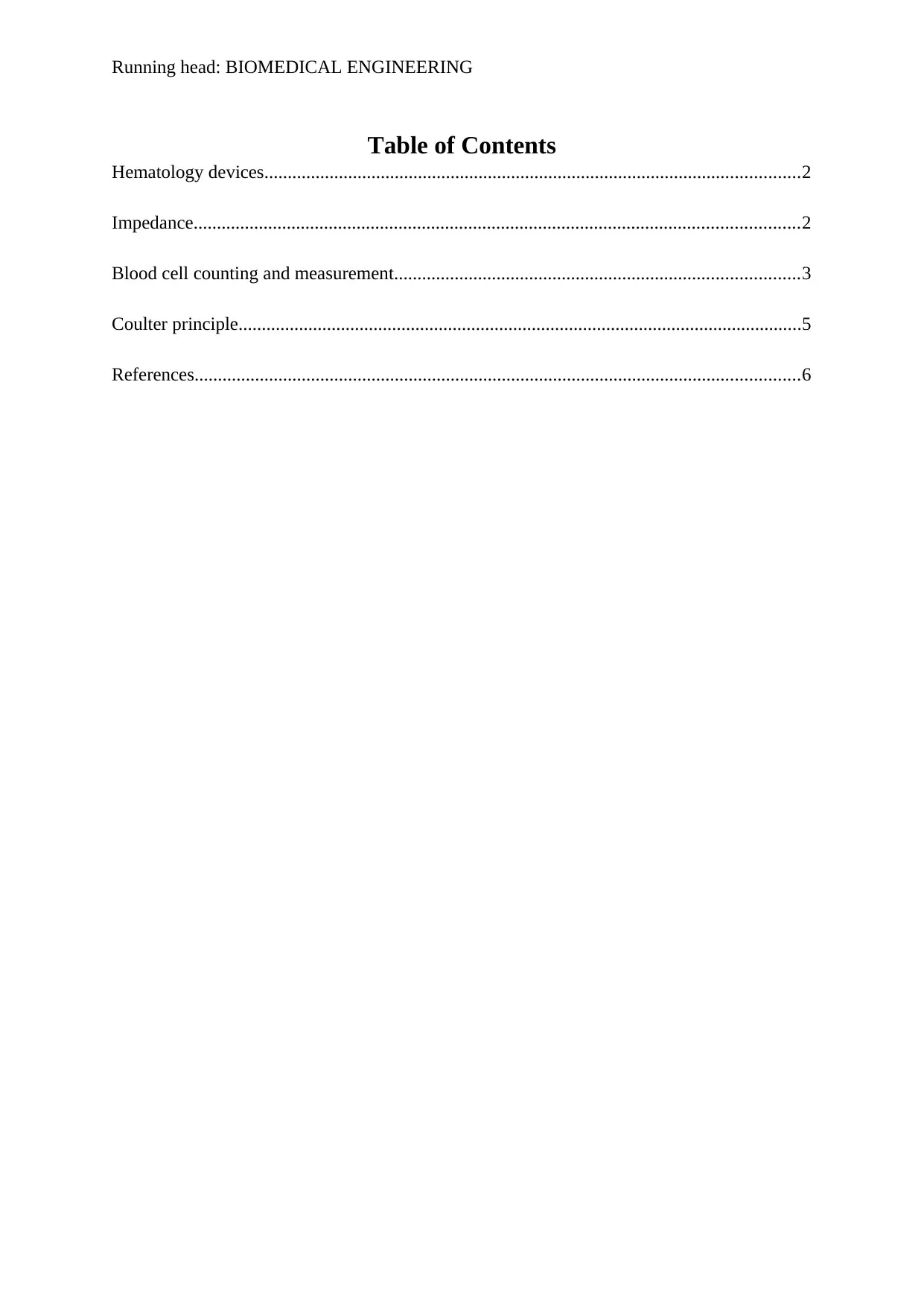
Running head: BIOMEDICAL ENGINEERING
Table of Contents
Hematology devices...................................................................................................................2
Impedance..................................................................................................................................2
Blood cell counting and measurement.......................................................................................3
Coulter principle.........................................................................................................................5
References..................................................................................................................................6
Table of Contents
Hematology devices...................................................................................................................2
Impedance..................................................................................................................................2
Blood cell counting and measurement.......................................................................................3
Coulter principle.........................................................................................................................5
References..................................................................................................................................6
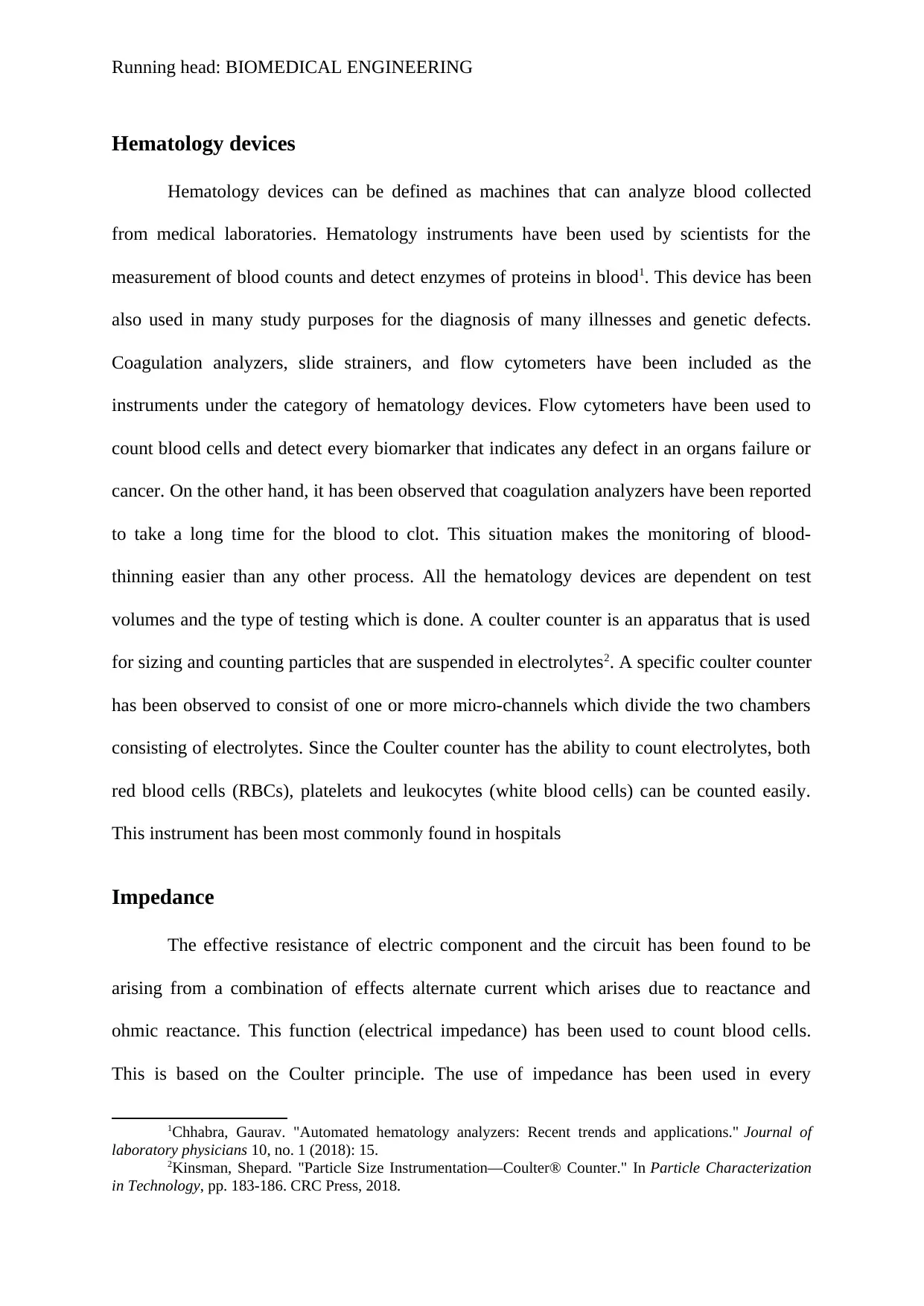
Running head: BIOMEDICAL ENGINEERING
Hematology devices
Hematology devices can be defined as machines that can analyze blood collected
from medical laboratories. Hematology instruments have been used by scientists for the
measurement of blood counts and detect enzymes of proteins in blood1. This device has been
also used in many study purposes for the diagnosis of many illnesses and genetic defects.
Coagulation analyzers, slide strainers, and flow cytometers have been included as the
instruments under the category of hematology devices. Flow cytometers have been used to
count blood cells and detect every biomarker that indicates any defect in an organs failure or
cancer. On the other hand, it has been observed that coagulation analyzers have been reported
to take a long time for the blood to clot. This situation makes the monitoring of blood-
thinning easier than any other process. All the hematology devices are dependent on test
volumes and the type of testing which is done. A coulter counter is an apparatus that is used
for sizing and counting particles that are suspended in electrolytes2. A specific coulter counter
has been observed to consist of one or more micro-channels which divide the two chambers
consisting of electrolytes. Since the Coulter counter has the ability to count electrolytes, both
red blood cells (RBCs), platelets and leukocytes (white blood cells) can be counted easily.
This instrument has been most commonly found in hospitals
Impedance
The effective resistance of electric component and the circuit has been found to be
arising from a combination of effects alternate current which arises due to reactance and
ohmic reactance. This function (electrical impedance) has been used to count blood cells.
This is based on the Coulter principle. The use of impedance has been used in every
1Chhabra, Gaurav. "Automated hematology analyzers: Recent trends and applications." Journal of
laboratory physicians 10, no. 1 (2018): 15.
2Kinsman, Shepard. "Particle Size Instrumentation—Coulter® Counter." In Particle Characterization
in Technology, pp. 183-186. CRC Press, 2018.
Hematology devices
Hematology devices can be defined as machines that can analyze blood collected
from medical laboratories. Hematology instruments have been used by scientists for the
measurement of blood counts and detect enzymes of proteins in blood1. This device has been
also used in many study purposes for the diagnosis of many illnesses and genetic defects.
Coagulation analyzers, slide strainers, and flow cytometers have been included as the
instruments under the category of hematology devices. Flow cytometers have been used to
count blood cells and detect every biomarker that indicates any defect in an organs failure or
cancer. On the other hand, it has been observed that coagulation analyzers have been reported
to take a long time for the blood to clot. This situation makes the monitoring of blood-
thinning easier than any other process. All the hematology devices are dependent on test
volumes and the type of testing which is done. A coulter counter is an apparatus that is used
for sizing and counting particles that are suspended in electrolytes2. A specific coulter counter
has been observed to consist of one or more micro-channels which divide the two chambers
consisting of electrolytes. Since the Coulter counter has the ability to count electrolytes, both
red blood cells (RBCs), platelets and leukocytes (white blood cells) can be counted easily.
This instrument has been most commonly found in hospitals
Impedance
The effective resistance of electric component and the circuit has been found to be
arising from a combination of effects alternate current which arises due to reactance and
ohmic reactance. This function (electrical impedance) has been used to count blood cells.
This is based on the Coulter principle. The use of impedance has been used in every
1Chhabra, Gaurav. "Automated hematology analyzers: Recent trends and applications." Journal of
laboratory physicians 10, no. 1 (2018): 15.
2Kinsman, Shepard. "Particle Size Instrumentation—Coulter® Counter." In Particle Characterization
in Technology, pp. 183-186. CRC Press, 2018.
⊘ This is a preview!⊘
Do you want full access?
Subscribe today to unlock all pages.

Trusted by 1+ million students worldwide

Running head: BIOMEDICAL ENGINEERING
hematology analyzer. Impedance has been found to change as the cells pass through the
separated chambers in a Coulter counter3.Impedance change has been found to be
proportional to the cellular volume and cell count. Thus, it can be said that both cell count
and volume can be measured by the impedance in a Coulter counter. The cells are counted as
soon as they alter the electrical impedance inside the Coulter counter. In the following
sections, the Coulter principle will be discussed in brief which will clarify the use of
impedance in cell count.
Blood cell counting and measurement
Blood cell-associated histograms have been produced by modern automated
hematology analyzers that can routinely be used for counting blood cells. The curves have
been also known as the CBC (complete blood count) histogram which are derived from the
cell size on X-axis and the relative cell numbers on Y-axis.
Fig 1: Clinical histogram (Counter counter)
Source: (4)
The X-axis has been found to represent the cell size and the Y-axis has been found to
measure the cell count. Dotted lines represent the cell debris and other cell types whereas
solid line represents the shape of peak including the living RBC counts4. A discriminator is
3Bonzon, David Vincent, Georges Henri Muller, Philippe Renaud, and Yann Barrandon. "Sensing tip
with electrical impedance sensor." U.S. Patent 10,352,954, issued July 16, 2019.
4Thomas, ET Arun, S. Bhagya, and Abdul Majeed. "Clinical utility of blood cell histogram
interpretation." Journal of clinical and diagnostic research: JCDR 11, no. 9 (2017): OE01.
hematology analyzer. Impedance has been found to change as the cells pass through the
separated chambers in a Coulter counter3.Impedance change has been found to be
proportional to the cellular volume and cell count. Thus, it can be said that both cell count
and volume can be measured by the impedance in a Coulter counter. The cells are counted as
soon as they alter the electrical impedance inside the Coulter counter. In the following
sections, the Coulter principle will be discussed in brief which will clarify the use of
impedance in cell count.
Blood cell counting and measurement
Blood cell-associated histograms have been produced by modern automated
hematology analyzers that can routinely be used for counting blood cells. The curves have
been also known as the CBC (complete blood count) histogram which are derived from the
cell size on X-axis and the relative cell numbers on Y-axis.
Fig 1: Clinical histogram (Counter counter)
Source: (4)
The X-axis has been found to represent the cell size and the Y-axis has been found to
measure the cell count. Dotted lines represent the cell debris and other cell types whereas
solid line represents the shape of peak including the living RBC counts4. A discriminator is
3Bonzon, David Vincent, Georges Henri Muller, Philippe Renaud, and Yann Barrandon. "Sensing tip
with electrical impedance sensor." U.S. Patent 10,352,954, issued July 16, 2019.
4Thomas, ET Arun, S. Bhagya, and Abdul Majeed. "Clinical utility of blood cell histogram
interpretation." Journal of clinical and diagnostic research: JCDR 11, no. 9 (2017): OE01.
Paraphrase This Document
Need a fresh take? Get an instant paraphrase of this document with our AI Paraphraser
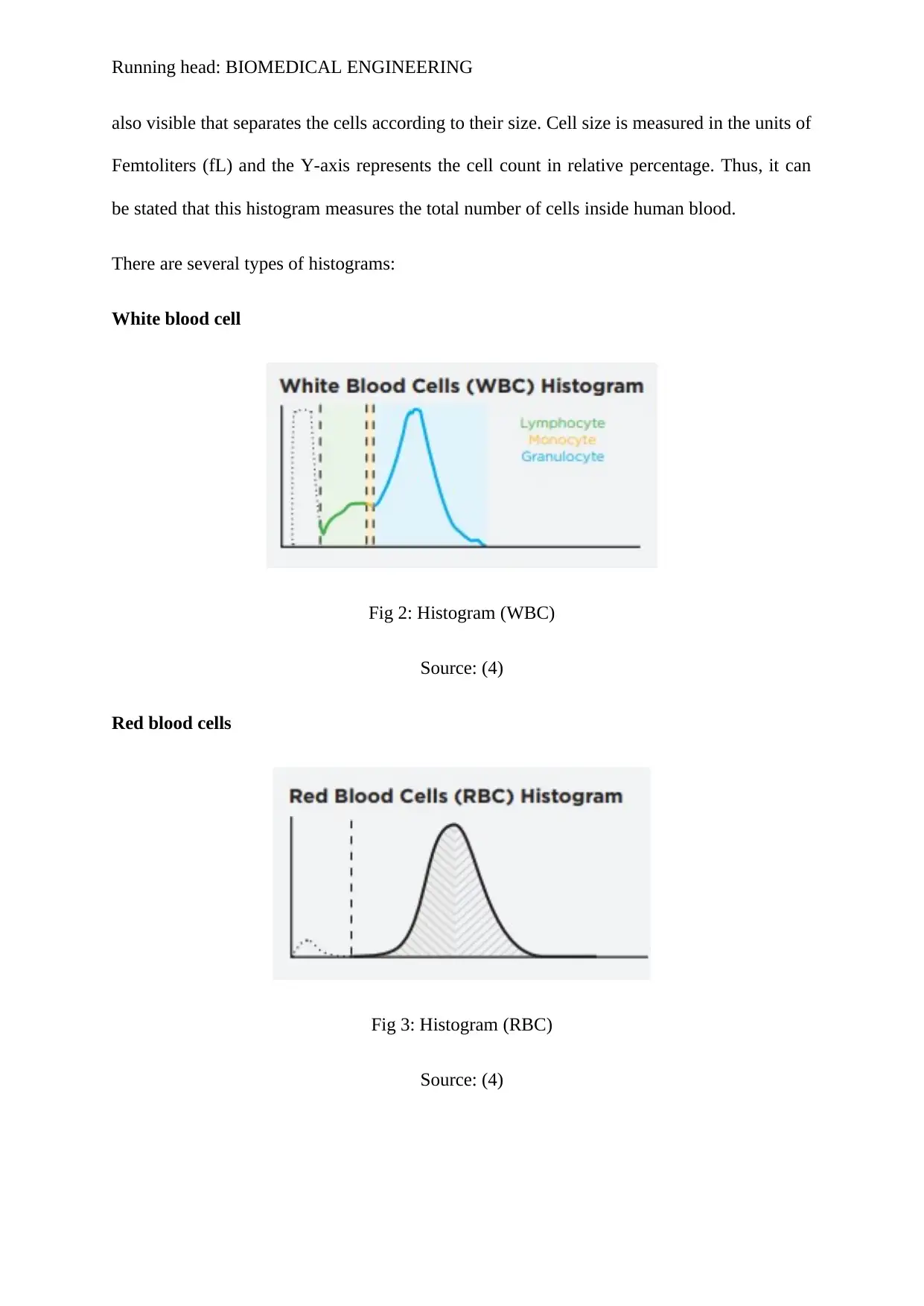
Running head: BIOMEDICAL ENGINEERING
also visible that separates the cells according to their size. Cell size is measured in the units of
Femtoliters (fL) and the Y-axis represents the cell count in relative percentage. Thus, it can
be stated that this histogram measures the total number of cells inside human blood.
There are several types of histograms:
White blood cell
Fig 2: Histogram (WBC)
Source: (4)
Red blood cells
Fig 3: Histogram (RBC)
Source: (4)
also visible that separates the cells according to their size. Cell size is measured in the units of
Femtoliters (fL) and the Y-axis represents the cell count in relative percentage. Thus, it can
be stated that this histogram measures the total number of cells inside human blood.
There are several types of histograms:
White blood cell
Fig 2: Histogram (WBC)
Source: (4)
Red blood cells
Fig 3: Histogram (RBC)
Source: (4)
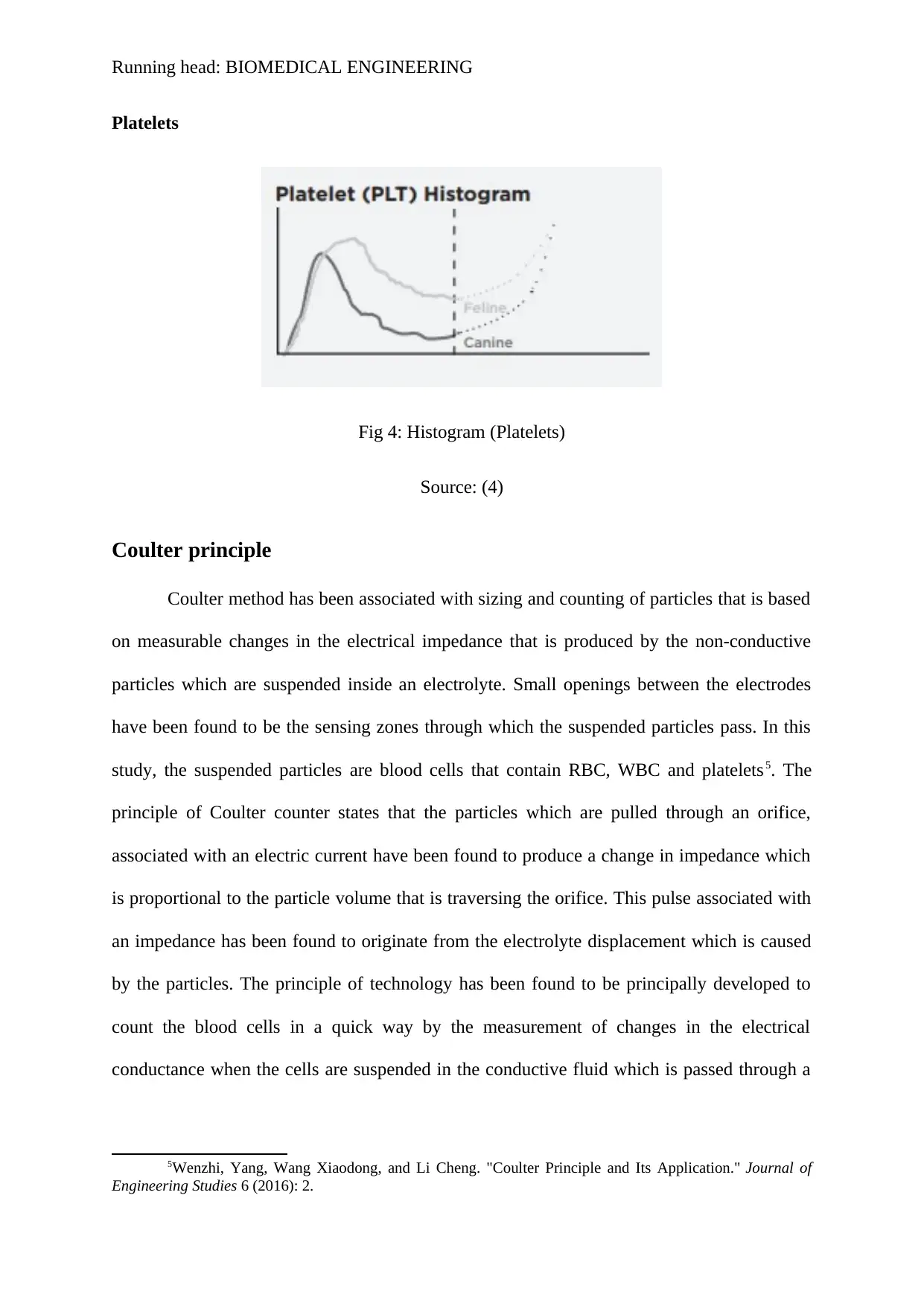
Running head: BIOMEDICAL ENGINEERING
Platelets
Fig 4: Histogram (Platelets)
Source: (4)
Coulter principle
Coulter method has been associated with sizing and counting of particles that is based
on measurable changes in the electrical impedance that is produced by the non-conductive
particles which are suspended inside an electrolyte. Small openings between the electrodes
have been found to be the sensing zones through which the suspended particles pass. In this
study, the suspended particles are blood cells that contain RBC, WBC and platelets5. The
principle of Coulter counter states that the particles which are pulled through an orifice,
associated with an electric current have been found to produce a change in impedance which
is proportional to the particle volume that is traversing the orifice. This pulse associated with
an impedance has been found to originate from the electrolyte displacement which is caused
by the particles. The principle of technology has been found to be principally developed to
count the blood cells in a quick way by the measurement of changes in the electrical
conductance when the cells are suspended in the conductive fluid which is passed through a
5Wenzhi, Yang, Wang Xiaodong, and Li Cheng. "Coulter Principle and Its Application." Journal of
Engineering Studies 6 (2016): 2.
Platelets
Fig 4: Histogram (Platelets)
Source: (4)
Coulter principle
Coulter method has been associated with sizing and counting of particles that is based
on measurable changes in the electrical impedance that is produced by the non-conductive
particles which are suspended inside an electrolyte. Small openings between the electrodes
have been found to be the sensing zones through which the suspended particles pass. In this
study, the suspended particles are blood cells that contain RBC, WBC and platelets5. The
principle of Coulter counter states that the particles which are pulled through an orifice,
associated with an electric current have been found to produce a change in impedance which
is proportional to the particle volume that is traversing the orifice. This pulse associated with
an impedance has been found to originate from the electrolyte displacement which is caused
by the particles. The principle of technology has been found to be principally developed to
count the blood cells in a quick way by the measurement of changes in the electrical
conductance when the cells are suspended in the conductive fluid which is passed through a
5Wenzhi, Yang, Wang Xiaodong, and Li Cheng. "Coulter Principle and Its Application." Journal of
Engineering Studies 6 (2016): 2.
⊘ This is a preview!⊘
Do you want full access?
Subscribe today to unlock all pages.

Trusted by 1+ million students worldwide

Running head: BIOMEDICAL ENGINEERING
small orifice6. Above 98% of the automated cell, counters have been found to incorporate the
technology which is referred to as the Counter principle. Whole blood has been made to pass
between the two electrodes through the orifice which is very narrow7. This narrowness allows
only one cell to pass through it at a time. This process allows the transfer of whole blood that
is passed in between the two electrodes which make the count easier. Problems with count
have been found to be avoided because of the fact that only one cell can pass through an
apparatus at time8. This principle has been used in various diagnostic centers and oncology
departments which include the diagnosis of anemia, sickle cell disease, hemophilia, and other
diseases. This is all about the principle of Coulter counter.
6Bonzon, David Vincent, Jean-Pierre Bonzon, Georges Henri Muller, Jean-Baptiste Bureau, Yann
Barrandon, Philippe Renaud, David Forchelet, and Nicolas Uffer. Tip connector for fluidic and electrical
connection. No. PATENT. 2018.
7Kemble, Samuel, Carol Briggs, and Paul Harrison. "Platelet Counting." In Platelets, pp. 581-591.
Academic Press, 2019.
8Vembadi, Abhishek, Anoop Menachery, and Mohammad A. Qasaimeh. "Cell cytometry: review and
perspective on biotechnological advances." Frontiers in bioengineering and biotechnology 7 (2019).
small orifice6. Above 98% of the automated cell, counters have been found to incorporate the
technology which is referred to as the Counter principle. Whole blood has been made to pass
between the two electrodes through the orifice which is very narrow7. This narrowness allows
only one cell to pass through it at a time. This process allows the transfer of whole blood that
is passed in between the two electrodes which make the count easier. Problems with count
have been found to be avoided because of the fact that only one cell can pass through an
apparatus at time8. This principle has been used in various diagnostic centers and oncology
departments which include the diagnosis of anemia, sickle cell disease, hemophilia, and other
diseases. This is all about the principle of Coulter counter.
6Bonzon, David Vincent, Jean-Pierre Bonzon, Georges Henri Muller, Jean-Baptiste Bureau, Yann
Barrandon, Philippe Renaud, David Forchelet, and Nicolas Uffer. Tip connector for fluidic and electrical
connection. No. PATENT. 2018.
7Kemble, Samuel, Carol Briggs, and Paul Harrison. "Platelet Counting." In Platelets, pp. 581-591.
Academic Press, 2019.
8Vembadi, Abhishek, Anoop Menachery, and Mohammad A. Qasaimeh. "Cell cytometry: review and
perspective on biotechnological advances." Frontiers in bioengineering and biotechnology 7 (2019).
Paraphrase This Document
Need a fresh take? Get an instant paraphrase of this document with our AI Paraphraser
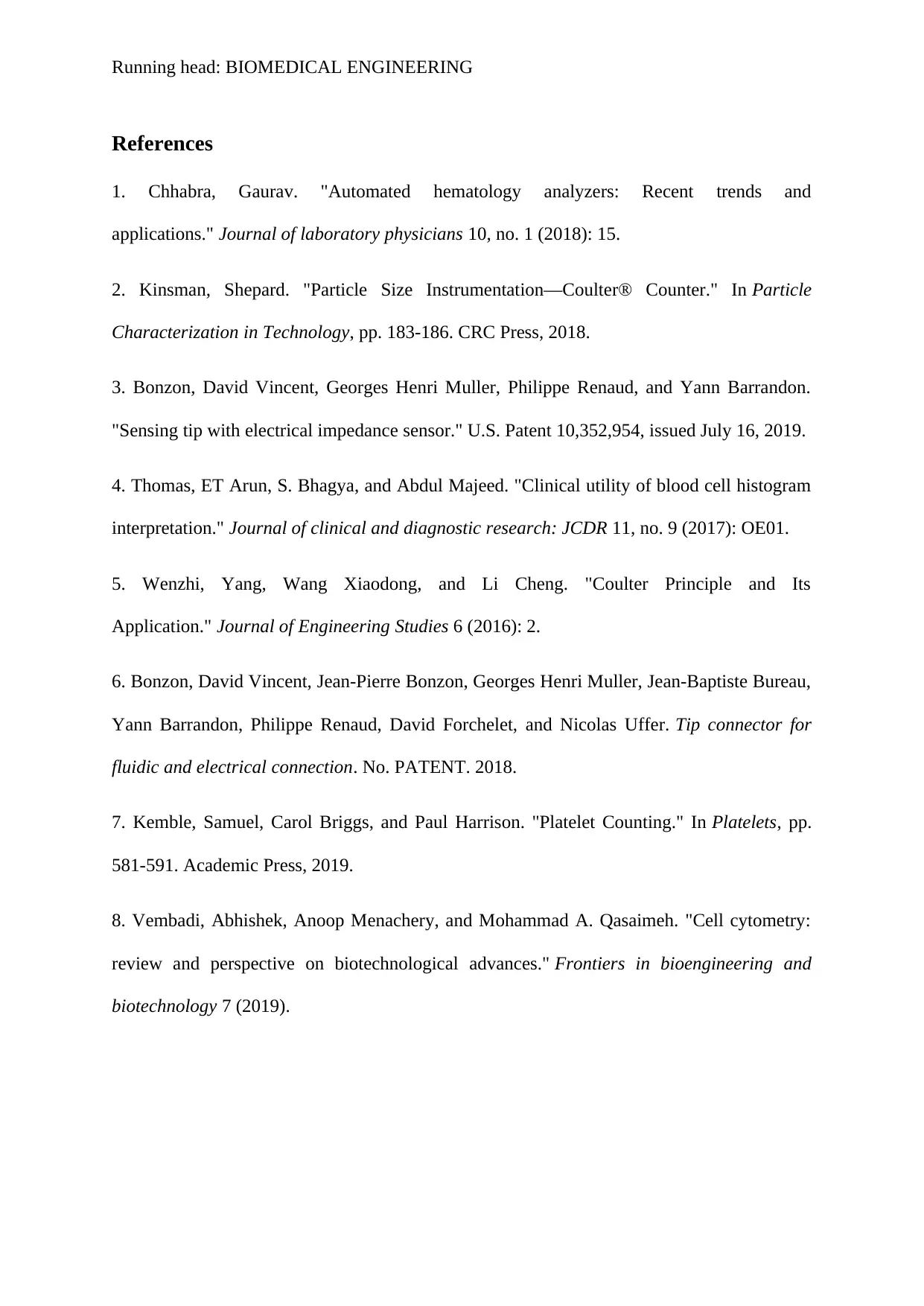
Running head: BIOMEDICAL ENGINEERING
References
1. Chhabra, Gaurav. "Automated hematology analyzers: Recent trends and
applications." Journal of laboratory physicians 10, no. 1 (2018): 15.
2. Kinsman, Shepard. "Particle Size Instrumentation—Coulter® Counter." In Particle
Characterization in Technology, pp. 183-186. CRC Press, 2018.
3. Bonzon, David Vincent, Georges Henri Muller, Philippe Renaud, and Yann Barrandon.
"Sensing tip with electrical impedance sensor." U.S. Patent 10,352,954, issued July 16, 2019.
4. Thomas, ET Arun, S. Bhagya, and Abdul Majeed. "Clinical utility of blood cell histogram
interpretation." Journal of clinical and diagnostic research: JCDR 11, no. 9 (2017): OE01.
5. Wenzhi, Yang, Wang Xiaodong, and Li Cheng. "Coulter Principle and Its
Application." Journal of Engineering Studies 6 (2016): 2.
6. Bonzon, David Vincent, Jean-Pierre Bonzon, Georges Henri Muller, Jean-Baptiste Bureau,
Yann Barrandon, Philippe Renaud, David Forchelet, and Nicolas Uffer. Tip connector for
fluidic and electrical connection. No. PATENT. 2018.
7. Kemble, Samuel, Carol Briggs, and Paul Harrison. "Platelet Counting." In Platelets, pp.
581-591. Academic Press, 2019.
8. Vembadi, Abhishek, Anoop Menachery, and Mohammad A. Qasaimeh. "Cell cytometry:
review and perspective on biotechnological advances." Frontiers in bioengineering and
biotechnology 7 (2019).
References
1. Chhabra, Gaurav. "Automated hematology analyzers: Recent trends and
applications." Journal of laboratory physicians 10, no. 1 (2018): 15.
2. Kinsman, Shepard. "Particle Size Instrumentation—Coulter® Counter." In Particle
Characterization in Technology, pp. 183-186. CRC Press, 2018.
3. Bonzon, David Vincent, Georges Henri Muller, Philippe Renaud, and Yann Barrandon.
"Sensing tip with electrical impedance sensor." U.S. Patent 10,352,954, issued July 16, 2019.
4. Thomas, ET Arun, S. Bhagya, and Abdul Majeed. "Clinical utility of blood cell histogram
interpretation." Journal of clinical and diagnostic research: JCDR 11, no. 9 (2017): OE01.
5. Wenzhi, Yang, Wang Xiaodong, and Li Cheng. "Coulter Principle and Its
Application." Journal of Engineering Studies 6 (2016): 2.
6. Bonzon, David Vincent, Jean-Pierre Bonzon, Georges Henri Muller, Jean-Baptiste Bureau,
Yann Barrandon, Philippe Renaud, David Forchelet, and Nicolas Uffer. Tip connector for
fluidic and electrical connection. No. PATENT. 2018.
7. Kemble, Samuel, Carol Briggs, and Paul Harrison. "Platelet Counting." In Platelets, pp.
581-591. Academic Press, 2019.
8. Vembadi, Abhishek, Anoop Menachery, and Mohammad A. Qasaimeh. "Cell cytometry:
review and perspective on biotechnological advances." Frontiers in bioengineering and
biotechnology 7 (2019).
1 out of 8
Your All-in-One AI-Powered Toolkit for Academic Success.
+13062052269
info@desklib.com
Available 24*7 on WhatsApp / Email
![[object Object]](/_next/static/media/star-bottom.7253800d.svg)
Unlock your academic potential
Copyright © 2020–2025 A2Z Services. All Rights Reserved. Developed and managed by ZUCOL.

